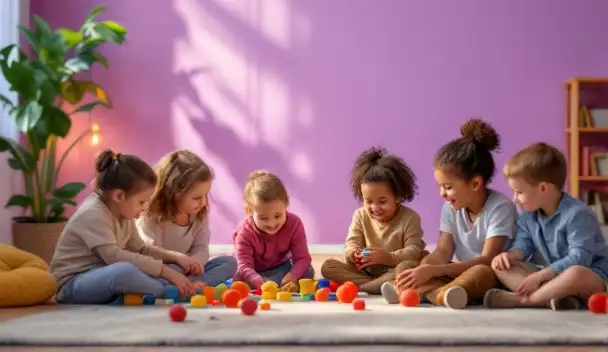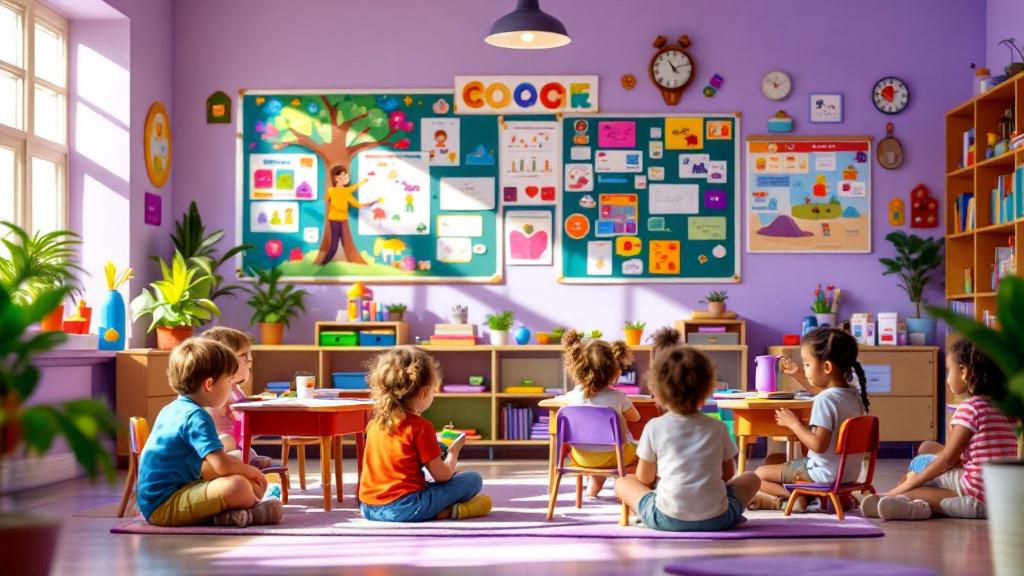Building Emotional Intelligence with ABA Therapy
Applied Behavior Analysis (ABA) therapy is a proven, systematic approach that significantly enhances emotional intelligence in children and individuals with autism spectrum disorder (ASD). By employing targeted strategies and evidence-based techniques, ABA fosters emotional recognition, regulation, and social understanding, ultimately improving overall well-being and interpersonal skills.
Core Techniques and Strategies in ABA for Emotional Skills Development
What techniques and strategies are used in ABA therapy to build emotional skills?
ABA therapy integrates a range of research-supported methods to help children with autism develop crucial emotional skills. These approaches are designed to enhance emotional awareness, self-regulation, and social understanding.
One fundamental element is the use of visual supports such as emotion charts and social stories. These tools help children identify and comprehend different emotions by providing clear visuals and narratives. For example, emotion cards depicting feelings like happiness or anger, combined with descriptive labels, assist children in recognizing and communicating their own emotions.
In addition to visual aids, ABA employs modeling, role-playing, prompting, and Discrete Trial Teaching (DTT). These techniques actively teach children how to respond appropriately in social and emotional situations. Therapists demonstrate desired behaviors, guide children through practice scenarios, and reinforce correct responses to foster learning.
Role-playing involves simulating real-world interactions where children practice sharing, turn-taking, and expressing emotions. Prompting provides cues or hints to encourage desired responses, gradually fading as the child gains independence.
Teaching coping strategies is also vital. Techniques such as deep breathing exercises, calming visuals, and mindfulness activities help children manage intense emotions and stay calm during challenging situations.
Another important aspect is promoting self-monitoring and functional communication. Children are encouraged to recognize their feelings and articulate them using words, gestures, or communication devices like PECS or AAC. This self-awareness supports empathy and perspective-taking.
Furthermore, activities that foster perspective-taking challenge children to understand others’ feelings and viewpoints, which is essential for emotional intelligence. Visual supports like social stories and videos illustrate social cues and appropriate responses, reinforcing understanding.
Overall, ABA therapy combines these evidence-based strategies to build a solid foundation for emotional skills. This holistic approach helps children navigate their emotional landscapes effectively, improving their social interactions and overall well-being.
| Technique | Description | Example |
|---|---|---|
| Visual Supports | Using pictures, stories, and visual cues to identify emotions | Emotion cards, social stories |
| Modeling and Role-Playing | Demonstrating and practicing emotional responses | Acting out social scenarios |
| Prompting and Reinforcement | Giving hints and positive feedback to encourage correct responses | Verbal prompts, praise |
| Teaching Coping Strategies | Techniques like deep breathing and calming visuals | Guided breathing exercises |
| Self-Monitoring & Communication | Recognizing feelings and expressing them effectively | Feelings journals, communication devices |
| Perspective-Taking Activities | Understanding others’ emotions and viewpoints | Social stories, video modeling |
Developing emotional skills in children with autism is a continuous process. ABA therapy’s structured, supportive, and systematic techniques help children build these abilities step-by-step, leading to improved emotional health and social competence.
The Benefits of ABA in Emotional and Social Development
What are the benefits of ABA therapy for emotional regulation and social skills development?
Applied Behavior Analysis (ABA) therapy has shown significant positive impacts on both emotional regulation and social skills, especially for children with autism spectrum disorder. It employs a variety of strategies aimed at helping children understand and manage their emotions effectively. For example, through activities like emotion charades and visual tools such as emotion cards, children learn to recognize and label different feelings. This foundational skill enables better emotional awareness and facilitates appropriate responses.
ABA therapy also promotes emotional flexibility by encouraging the use of self-regulation techniques such as deep breathing exercises, guided visualization, and coping strategies. These habits help children manage stress, frustration, and difficult emotions more adaptively. Reinforcement and modeling are central to these interventions, leading to improved resilience over time.
On the social front, ABA helps improve understanding of social cues like facial expressions, body language, and tone of voice. Through role-playing, social stories, and video modeling, children practice interpreting these cues in a safe setting. This enhances their ability to engage in reciprocal conversations, take turns, share, and respect personal boundaries.
Furthermore, ABA promotes effective communication skills. Goals include expanding vocabulary, teaching alternative communication methods such as picture exchange communication systems (PECS), and encouraging expressive body language. As children develop these skills, their ability to connect with others and navigate social environments improves.
Effective ABA interventions are tailored specifically to individual needs, which supports long-term growth. Children often see lasting improvements in emotional regulation, social competence, and overall quality of life. These gains foster not just better day-to-day interactions but also lay the groundwork for lifelong social and emotional well-being.
What aspects of social and emotional growth does ABA influence?
| Aspect | How ABA Facilitates Growth | Additional Insights |
|---|---|---|
| Emotional Regulation | Recognition, labeling, understanding emotions | Techniques like emotion cards, journals, and mindfulness exercises |
| Resilience and Coping Skills | Stress management, frustration tolerance | Reinforced through role-playing and systematic reinforcement |
| Interpreting Social Cues | Facial expressions, body language, tone | Video modeling, social stories, and natural environment teaching |
| Communication Skills | Vocabulary expansion, alternative methods (PECS) | Practice with social stories, visual supports, and interactive play |
| Social Interaction | Turn-taking, sharing, respectful boundaries | Group activities, cooperative play, peer-mediated instruction |
Which specific techniques are used in ABA to support emotional and social development?
- Discrete Trial Training (DTT)
- Natural Environment Teaching (NET)
- Social stories
- Video modeling
- Peer-mediated instruction
- Emotion charades and visual emotion cards
- Feelings journals and social narratives
- Mindfulness and breathing exercises
These methods are evidence-based and designed to develop specific skills systematically. They make social and emotional development tangible and attainable for children with autism.
How does parental involvement enhance ABA outcomes?
Parents play a crucial role by reinforcing learned skills at home, participating in therapy sessions, and practicing techniques like emotion recognition and social stories. Their active engagement helps transfer skills from therapy to real-world settings, ensuring consistent growth.
In conclusion, ABA therapy is comprehensive in promoting emotional intelligence and social competence. Its structured, personalized approach helps children recognize, understand, and regulate their emotions, while also improving their capacity to connect with others socially. This ultimately leads to improved relationships and a better quality of life.
The Role of ABA in Enhancing Social and Emotional Understanding
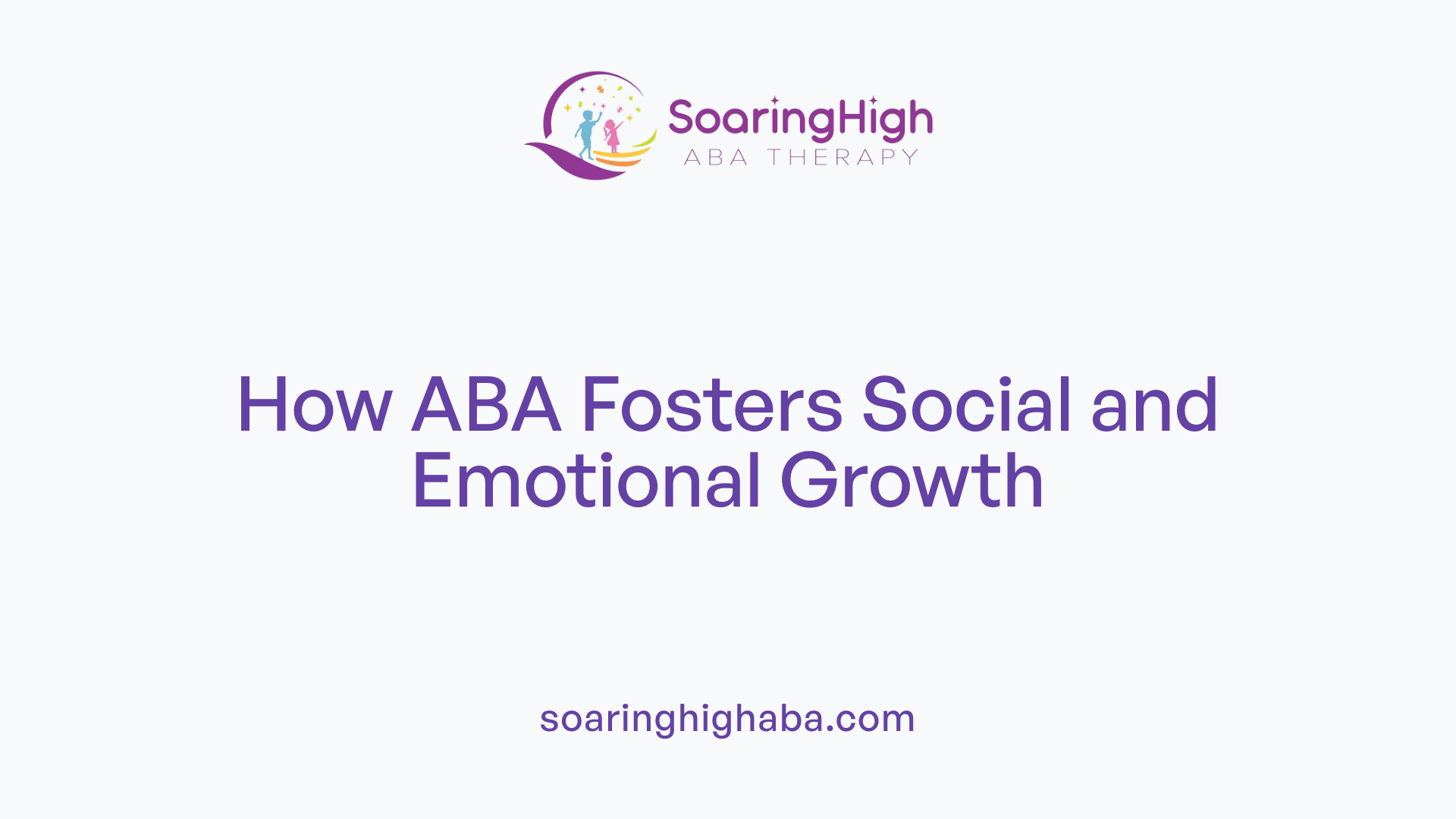
What role does ABA therapy play in enhancing social and emotional understanding?
Applied Behavior Analysis (ABA) therapy is a well-respected, evidence-based approach that significantly supports children with autism in developing essential social and emotional skills. Its structured methodology focuses on teaching children to recognize, interpret, and appropriately respond to various social cues and emotional states.
ABA therapy's strength lies in its systematic breakdown of complex skills into manageable steps. Therapists employ strategies such as visual supports—emotion cards with images and descriptions of feelings like happiness, sadness, or anger—that help children identify and articulate their emotions. These visual tools foster emotional vocabulary development, making it easier for children to express themselves and understand others.
Social stories are another effective tool used in ABA. These narratives, often complemented by images, teach children about social norms, cues, and appropriate reactions in diverse situations. Through role-playing, children practice social interactions in a safe environment, gaining confidence and understanding of social dynamics.
In addition to teaching social recognition, ABA emphasizes emotional regulation. Techniques like deep breathing exercises, mindfulness practices, and the use of zones of regulation—color-coded systems that help children recognize and manage their feelings—are incorporated into therapy routines. These tools help children develop self-awareness and calmness, reducing anxiety and emotional outbursts.
ABA's individualized approach considers each child's unique needs, creating opportunities for resilient and positive social engagement. Group activities such as cooperative play or peer-mediated instruction facilitate real-life practice of social skills, fostering peer relationships and emotional understanding.
By integrating these diverse techniques, ABA therapy enhances social competence and emotional well-being. Children learn not only to navigate social situations more effectively but also to build resilience against challenges, strengthening their overall emotional health.
Techniques and tools used in ABA for social and emotional skill development
| Technique/Tool | Purpose | Additional Details |
|---|---|---|
| Visual supports (emotion cards) | Recognize and communicate feelings | Visual cues help children identify emotions and improve emotional vocabulary |
| Social stories | Teach social norms and appropriate responses | Narratives enhance understanding of social cues in various contexts |
| Role-playing | Practice social interactions and emotional responses | Safe environment for skill rehearsal |
| Deep breathing & mindfulness | Regulate emotions and promote calmness | Techniques like guided visualization and deep breaths support stress management |
| Zones of Regulation | Self-awareness and emotional regulation | Color-coded system for identifying feelings |
| Video modeling | Demonstrate appropriate social behaviors | Videos show real-life examples, reinforcing learning |
| Peer-mediated instruction | Encourage natural social interactions | Promotes generalization of skills through peers |
| Social stories and narratives | Enhance understanding of social cues | Use of visuals and storytelling to teach social understanding |
How do visual supports and role-playing help build social and emotional skills?
Visual supports, like emotion cards and social stories, provide concrete references that make abstract social and emotional concepts more accessible to children with autism. They serve as visual reminders and aid in understanding emotions and social expectations.
Role-playing offers hands-on practice of social scenarios. By acting out different situations, children learn appropriate responses, develop empathy, and gain confidence in their social abilities. Therapists actively participate, modeling behavior and guiding children through responses, which helps solidify skills and promotes generalization to real-life contexts.
Addressing emotional regulation with coping tools like deep breathing and Zones of Regulation
Emotional regulation is a critical component of social success. ABA therapy incorporates coping mechanisms such as deep breathing exercises and mindfulness activities to facilitate emotional self-regulation.
The Zones of Regulation system categorizes feelings into different color zones, helping children recognize and label their emotions. Through targeted activities, children learn to use appropriate strategies—like breathing exercises or taking a break—to manage overwhelming feelings.
This focus on emotional regulation not only improves individual well-being but also enhances social interactions by reducing frustrations and emotional outbursts.
Promoting resilience and supportive social interactions
Because children with autism face unique social challenges, ABA programs aim to foster resilience and positive interactions. Structured activities, reinforcement strategies, and family involvement help create a supportive environment where children feel safe to explore social roles.
Encouraging sibling participation and group involvement extends social learning beyond therapy sessions. Celebrating successes and reinforcing positive behavior further builds confidence and emotional strength.
Together, these practices prepare children to face social environments with greater resilience, empathy, and understanding, laying a strong foundation for lifelong social and emotional growth.
Facilitating Emotional Growth in Children with Autism Spectrum Disorder
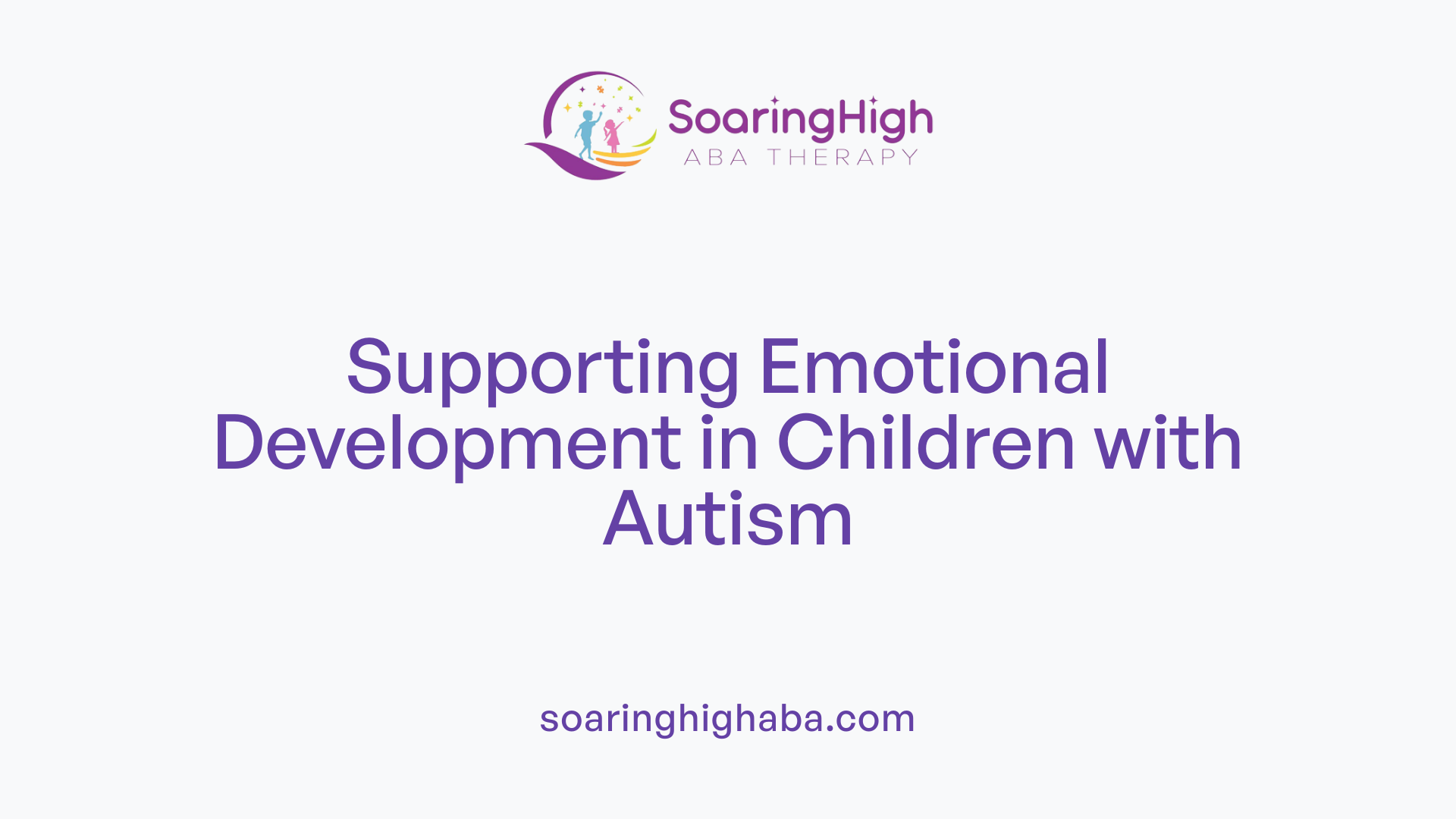
How does ABA therapy aid in emotional growth within individuals on the autism spectrum?
ABA therapy plays a significant role in fostering emotional development among children with autism. It focuses on helping these children recognize, understand, and regulate their emotions more effectively.
One of the primary methods involves teaching children to label their feelings accurately. Using visual tools such as emotion cards featuring faces expressing happiness, sadness, anger, or fear allows children to associate words with their internal states. Modeling appropriate emotional responses through role-playing and social stories provides children with clear examples of how to behave in different situations.
Practicing calming techniques, like deep breathing exercises or mindfulness activities, is another aspect of ABA that supports emotional regulation. These strategies help children manage intense feelings and reduce anxiety, creating a sense of emotional safety.
Creating a structured environment is crucial. ABA emphasizes predictability and routine, which reduce uncertainty and stress. When children know what to expect, they tend to feel more secure, making it easier to explore and express their emotions.
Reinforcing positive social interactions and communication skills is also central to fostering emotional growth. Through rewards and praise, children are encouraged to engage more actively with peers and adults, building their confidence and social-emotional bonds.
Naturalistic and play-based methods integrate emotional learning into everyday activities. For instance, during play, therapists might incorporate scenarios that require sharing, taking turns, or expressing feelings about a game. This contextual approach makes emotional skills relevant and easier to generalize to real-life situations.
Overall, ABA therapy supports emotional growth by systematically building children’s ability to recognize and regulate their emotions, communicate effectively, and develop trust and resilience. These improvements contribute significantly to their overall emotional well-being and personal development.
| Technique | Purpose | Methodology | Additional Details |
|---|---|---|---|
| Labeling Emotions | Enhance emotional vocabulary | Visual aids, social stories | Helps children identify and articulate feelings |
| Modeling and Role-Playing | Demonstrate appropriate responses | Therapist-led scenarios, peer interactions | Builds understanding of emotional expressions |
| Calming Techniques | Support self-regulation | Deep breathing, mindfulness exercises | Reduces emotional intensity and anxiety |
| Structured Environment | Provide predictability and safety | Routine, visual schedules | Lowers stress, fosters trust |
| Play and Naturalistic Learning | Apply emotional skills in real contexts | Play scenarios, social interactions | Encourages generalization of skills |
Research demonstrates that the deliberate incorporation of these strategies in ABA can lead to meaningful improvements in emotional awareness and regulation. As children develop these skills, they become better equipped to navigate social relationships, leading to increased independence and emotional resilience.
For further insights, searching
Supporting Emotional and Social Skills in Neurodiverse Populations
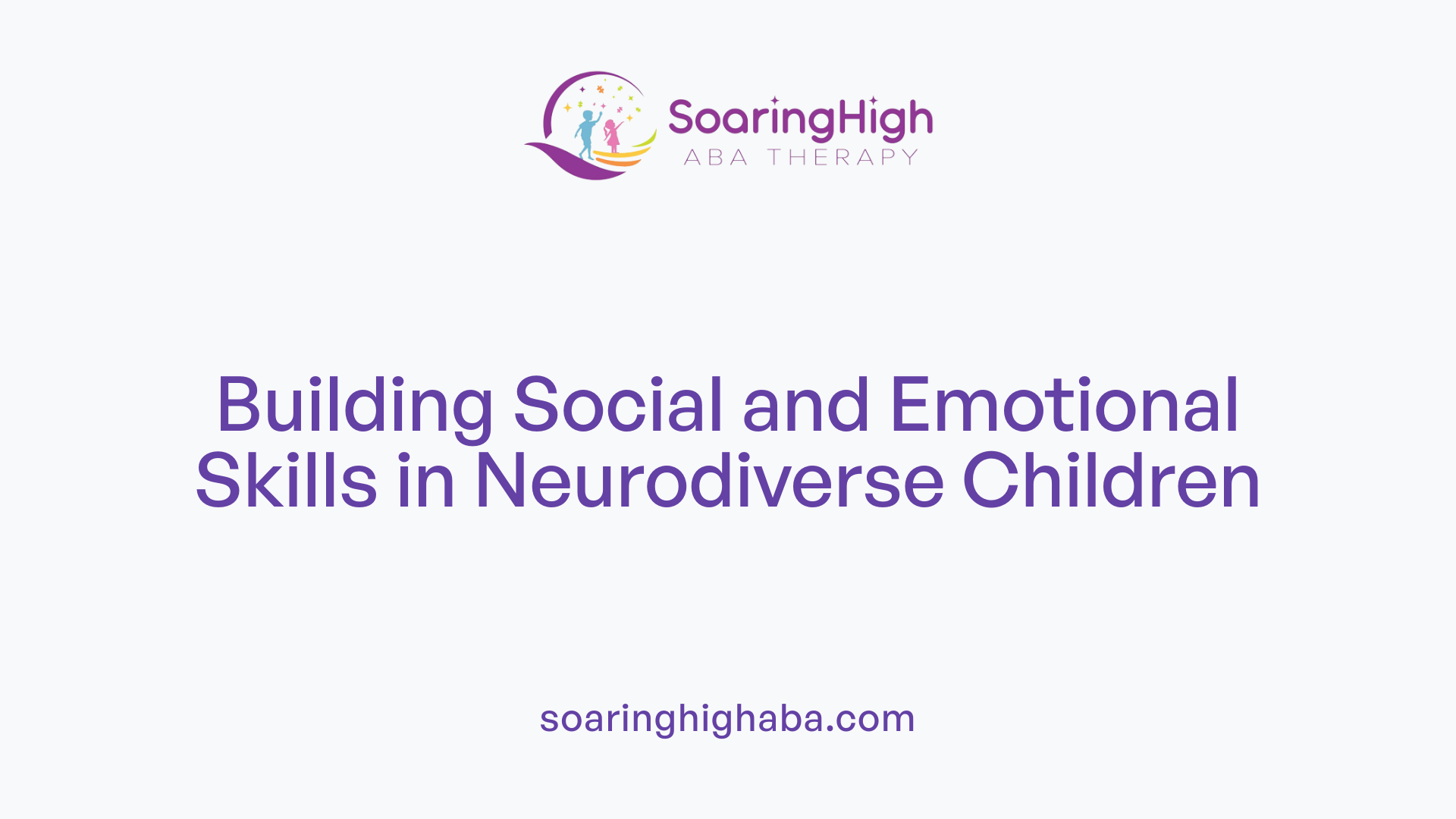
How does ABA therapy support emotional and social skill development in neurodiverse populations?
Applied Behavior Analysis (ABA) therapy plays a vital role in developing social and emotional skills among children with autism spectrum disorder (ASD) and other neurodiverse profiles. It focuses on creating individualized programs that address each child's unique needs, strengths, and interests. By tailoring interventions, therapists can maximize each child's learning potential.
ABA employs a variety of effective techniques to teach social and emotional skills. Positive reinforcement encourages children to repeat desirable behaviors such as eye contact, sharing, and active listening. Role-playing scenarios help children practice social exchanges and respond appropriately to different situations. Social stories provide relatable narratives that explain social norms and emotional cues, enhancing understanding. Video modeling offers visual examples of social interactions, which children can imitate.
Creating safe, structured environments for practicing social interactions is crucial. These settings might include play therapy sessions, group activities, or naturalistic interactions within the child’s daily routine. Such environments allow children to apply what they learn in real-time while feeling secure and supported.
Family involvement is essential for reinforcing skills beyond therapy sessions. Collaboration with parents and caregivers helps generalize behaviors across various settings, such as home and school. Consistent reinforcement and practice in multiple environments ensure that skills are maintained and refined.
Research and clinical evidence show that effective ABA programs can significantly improve social functioning, communication abilities, and emotional regulation over time. These programs typically last from one to three years, with consistent therapy leading to meaningful improvements.
In summary, ABA therapy systematically teaches practical social and emotional skills through tailored interventions, safe practice settings, and collaborative efforts with families. This comprehensive approach equips children with the tools necessary for engaging socially, understanding emotions, and building stronger relationships.
| Strategy | Description | Typical Use Cases |
|---|---|---|
| Positive Reinforcement | Encourages desired behaviors through rewards | Eye contact, sharing, turn-taking |
| Role-playing | Simulates social scenarios for practice | Responding to social cues, sharing emotions |
| Social Stories | Narrative tools that explain social norms and emotions | Understanding facial expressions, empathy |
| Video Modeling | Demonstrates appropriate behaviors through visual aids | Reciprocal conversations, body language |
| Natural Environment Teaching (NET) | Learning in natural, real-world settings | Play, mealtime, community outings |
What techniques are commonly used in ABA therapy to develop social skills?
ABA therapy incorporates evidence-based strategies like Discrete Trial Training (DTT), Social Stories, video modeling, and peer-mediated instruction. DTT breaks down complex skills into small, manageable steps, allowing children to learn progressively. Social stories and visual supports help children understand social cues and emotional contexts. Video modeling allows children to observe and imitate appropriate behaviors, enhancing social understandings. Peer-mediated instruction involves typically developing peers to model and reinforce social behaviors, facilitating natural social interactions. These methods, combining systematic teaching with reinforcement, promote meaningful improvements in social skills, emotional understanding, and communication.
How does therapy create safe spaces for practicing social interactions?
Therapy environments are designed to be supportive and non-intimidating, providing children with opportunities to explore and practice social skills without fear of judgment. Activities like play therapy, group sessions, and role-playing are structured to simulate social situations children may encounter outside therapy. Therapists actively model appropriate behaviors, guide children through social cues, and offer immediate feedback. This hands-on practice helps children build confidence, recognize emotional cues, and respond appropriately, leading to more natural social engagement in everyday life.
Why is collaboration with families important for generalizing skills?
Generalization of skills—applying learned behaviors across different settings—is vital. Families play a crucial role in reinforcing what children learn during therapy. By actively participating in training, providing consistent reinforcement, and practicing skills at home and in community settings, families help children transfer skills from the clinical environment to real-world situations. Family involvement ensures that progress is maintained and that social and emotional growth continues outside of structured sessions.
What are the outcomes of effective ABA programs regarding social, communication, and emotional skills?
When properly implemented, ABA therapy can lead to significant enhancements in social skills such as reciprocal conversation, respecting boundaries, sharing, and turn-taking. It also fosters improvements in emotional recognition and regulation, enabling children to understand and respond to their feelings and those of others. Overall, effective ABA programs contribute to better social integration, more effective communication, and increased emotional resilience. These improvements not only enhance daily interactions but also support long-term well-being, social success, and personal development.
Understanding the Neurological Foundations of ABA and Emotional Intelligence
What is the neurological basis of ABA therapy related to emotional intelligence, and what strategies are used?
The brain functions as the foundation for emotional intelligence (EI), which encompasses abilities such as recognizing, understanding, managing, and expressing emotions. In individuals with autism spectrum disorder (ASD), neurological differences often impact these processes, creating challenges in emotional perception and regulation.
Research indicates that higher levels of Ability EI are associated with specific patterns of brain connectivity. Notably, effective emotional regulation relies on the functional interactions between the limbic system—particularly structures like the amygdala—and the default mode network (DMN). The limbic system processes emotional reactions and memories, while the DMN facilitates self-referential thought and social cognition. Strong, well-regulated connectivity between these areas supports emotional awareness and adaptive responses.
In children with ASD, atypical connectivity in these regions can hamper emotional understanding and regulation. Neural pathways involved in emotional regulation include circuits connecting the prefrontal cortex with subcortical areas, which are crucial for impulse control, decision-making, and emotional modulation.
Traditional ABA therapy employs behaviorist techniques such as positive reinforcement, skill breakdown, and social modeling. While effective at shaping behaviors, ABA does not directly target the neurological circuits underlying emotional processing. However, emerging strategies aim to modify these foundational pathways.
Strategies like brain harmony programs focus on promoting neural organization through vagal regulation, sensory integration, and reflex integration. Vagal regulation techniques involve stimulating the vagus nerve to enhance parasympathetic activity, which promotes calmness and emotional stabilization.
Sensory integration therapy helps children process sensory inputs more effectively, reducing sensory overload that can disrupt emotional regulation. Reflex integration aims to re-establish primitive reflexes that, when retained beyond infancy, may interfere with neural development and emotional control.
These approaches seek to reorganize and calm the nervous system, thereby creating a neurological environment conducive to better emotional understanding and regulation. This neurological support complements behavioral interventions, providing a more comprehensive foundation for developing emotional intelligence.
Leveraging neuroplasticity, the brain's capacity to reorganize and form new connections, these strategies aim to enhance the neural substrates of emotional regulation. Improving neural connectivity between emotion-related brain regions facilitates more adaptive emotional responses, essential for social success.
In summary, understanding the neurological basis of emotional intelligence involves recognizing the roles of brain connectivity and neural pathways. Strategies like vagal regulation and sensory integration target these neural foundations, supporting children with autism in developing stronger emotional understanding and control. This integrated approach holds promise for fostering more profound and lasting improvements in emotional intelligence, complementing behavioral therapies like ABA.
Facilitating Emotional Awareness and Regulation in Children with Autism
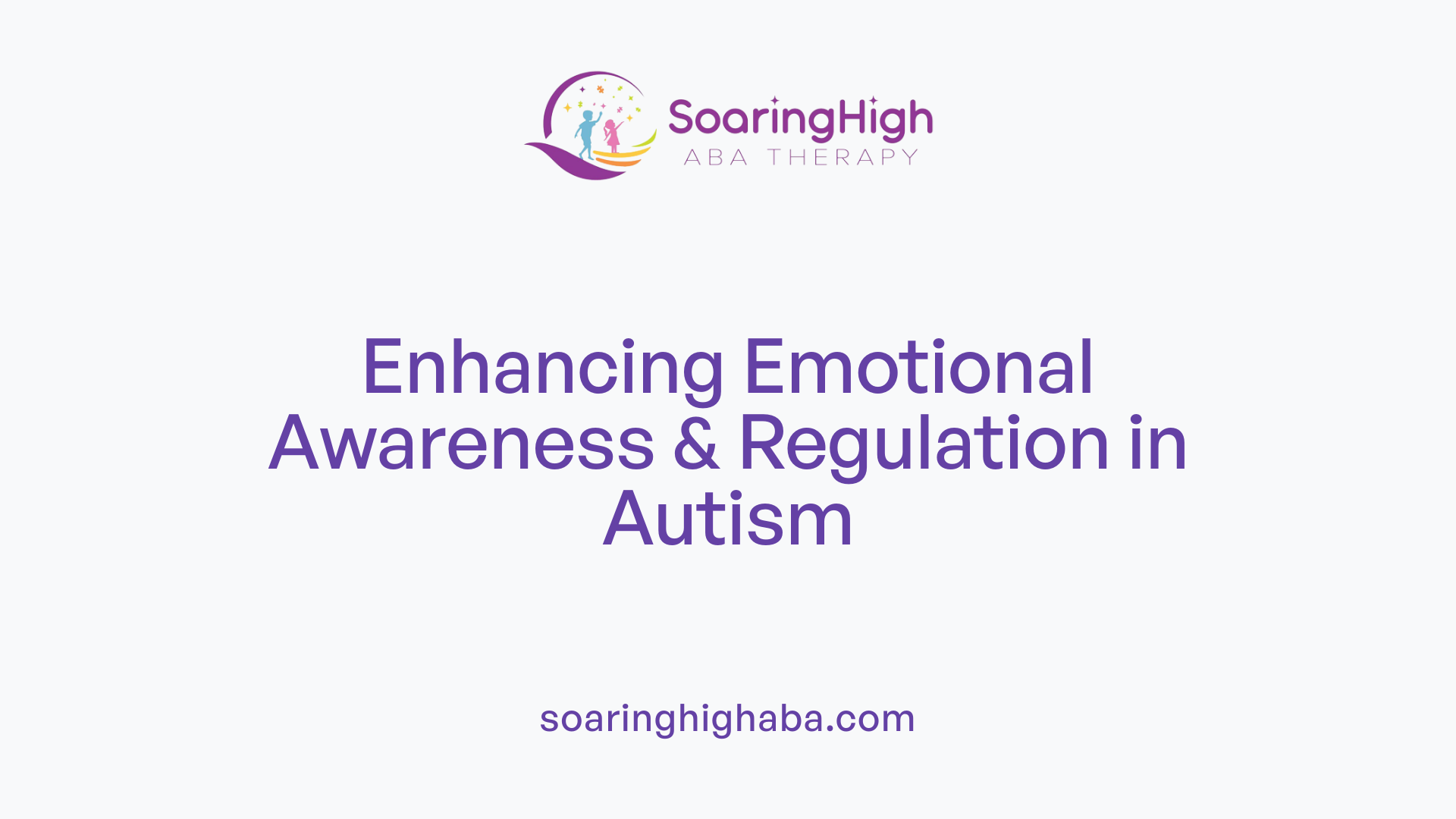
How can ABA therapy facilitate improved emotional awareness and regulation in children with autism?
ABA therapy plays a vital role in helping children with autism develop better emotional understanding and self-control. It does so by teaching children to recognize and label their emotions, which is often challenging due to differences in social cognition and sensory processing.
One of the primary methods used involves visual supports, such as emotion cards featuring pictures of facial expressions and descriptions of feelings like happiness, sadness, anger, or frustration. These tools help children visually connect with their internal states, making it easier to identify emotions. Social stories are also crafted to depict social and emotional situations, guiding children through appropriate reactions and responses.
Role-playing activities allow children to practice recognizing emotions in simulated settings, helping them generalize these skills to real-life interactions. By acting out scenarios like sharing, taking turns, or expressing disagreement, children learn how to manage their emotions effectively.
Modeling calm behavior is another crucial strategy. Therapists demonstrate composed responses during emotional episodes, reinforcing the idea that managing feelings constructively is possible. Reinforcing coping skills, such as deep breathing or using sensory tools, gives children tangible methods to calm themselves when overwhelmed.
ABA incorporates teaching self-regulation through mindfulness activities and establishing routines. These practices encourage children to pause, breathe, and reflect, which helps reduce emotional intensity and improve impulse control.
Creating a safe, predictable environment within therapy sessions is essential. It offers children the space to explore their emotions without fear of judgment, fostering emotional expression and resilience.
Collaboration with caregivers ensures consistency across settings. Parents and family members are taught similar strategies and reinforcement techniques to support emotional development at home. This unified approach reinforces learning and helps children transfer skills from therapy to everyday life.
In summary, ABA therapy enhances emotional intelligence by providing structured, individualized tools and strategies. These efforts collectively build emotional awareness, promote effective self-regulation, and lay a foundation for healthier social interactions and personal growth in children with autism.
Empowering Emotional Growth for a Brighter Future
ABA therapy stands as a cornerstone in fostering emotional intelligence among children and individuals with autism spectrum disorder. Through a blend of evidence-based techniques, individualized intervention plans, and collaborative efforts with families, ABA not only enhances social and emotional understanding but also empowers individuals to navigate their world with confidence, resilience, and empathy. As research continues to evolve, the integration of neurological insights and innovative strategies will further deepen the positive impact of ABA in emotional development, paving the way for more meaningful connections and improved quality of life for neurodiverse populations.
References
- Social Skills in ABA Therapy: Navigating the Social World
- ABA Therapy for Enhancing Social Skills in Children with Autism
- Enhancing Emotional Intelligence in ASD Children: 7 Engaging ...
- Autism Emotional Intelligence: Key Insights & Tips - Jade ABA Therapy
- How ABA Therapy Helps With Social Skills
- Supporting Siblings of Children in ABA Therapy - Therapyland
- Building Social Skills with ABA: A Step-by-Step Approach
- Unlocking Emotional Intelligence Through Therapy
- Teaching Emotional Intelligence with ABA - Therapyland
















































